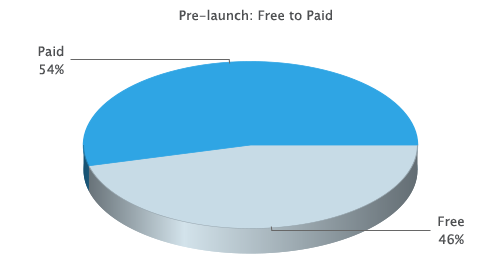This post is an excerpt from my upcoming book, Start Small, Stay Small: A Developer’s Guide to Launching a Startup.
If you haven’t already signed up to receive the “crazy pre-release deal” when the book launches, you can do so at the startup book website.
==
One piece of your marketing that you need to nail down is your “hook.”
This is not your Unique Selling Proposition, and it’s not your elevator pitch. It’s the headline of your home page. That single sentence that grabs the reader in and makes her know she’s in the right place.
- DotNetInvoice’s hook is “Save Time. Get Paid Faster.”
- FogBugz’s hook is “Bring Your Project into Focus”
- Basecamp’s hook is “The Better Way to Get Projects Done”
- Bidsketch’s hook is “Simple Proposal Software Made for Designers”
- When it was launched, the iPod’s hook was “One Thousand Songs in Your Pocket”
These are 5-7 word summaries of your product. Each one conveys an image in your mind. Each one describes what the product does and (in most cases) who it’s made for.
The benefit to finding your hook (which I also call “your 4-second pitch”) is when you meet someone face to face and they ask what your startup does, it’s your description. In 4-seconds you tell them clearly and concisely what it is that you do:
“We build invoicing software that helps entrepreneurs save time and get paid faster.”
Finding It
To find your hook you can take one of three approaches:
- Explain what your product does and for whom. Such as “Simple proposal software made for designers.”
- Make a promise to the customer espousing a benefit of your product, such as “Save Time. Get Paid Faster.”
- Describe the single most remarkable feature of your product, such as “One Thousand Songs in Your Pocket.”
Some other fake examples for something as boring as inventory software made for grocery stores:
- What it does and for whom: Inventory Tracking for Grocery Stores
- Promise: Automate Your Inventory
- Feature: A Million Items at your Fingertips
Spend a few minutes brainstorming your hook; it’s surprisingly easy to create one. Keep the words short and simply; no marketing speak. Discuss it with a friend or colleague in your target market to find out if it pulls him in.
Once you’ve decided on a hook you should put it as the header on your home page, and consider using it as your tagline. This hook is what will allow you to tell someone in 3 seconds what your product does, or at least why it’s so cool that they need to check it out.
An Invitation
Once you find your hook, post it in the comments with a link to your site. Consider this permission to do a little marketing for your startup or product.
With the purpose of this exercise in mind, keep it to one sentence plus your URL.
Finding Your Hook
One of the most difficult pieces of marketing to create is your “hook.” This is not your Unique Selling Proposition, and it’s not your elevator pitch. It’s the headline of your home page. That single sentence that grabs the reader in and makes her know she’s in the right place.
· DotNetInvoice’s hook is “Save Time. Get Paid Faster.”
· FogBugz’s hook is “Bring Your Project into Focus”
· Basecamp’s hook is “The Better Way to Get Projects Done”
· Bidsketch’s hook is “Simple Proposal Software Made for Designers”
· When it was launched, the iPod’s hook was “One Thousand Songs in Your Pocket”
These are 5-7 word summaries of your product. Each one conveys an image in your mind. Each one describes what the product does and (in most cases) who it’s made for.
To find your hook you can take one of three approaches:
1. Explain what your product does and for whom. Such as “Simple proposal software made for designers.”
2. Make a promise to the customer espousing a benefit of your product, such as “Save Time. Get Paid Faster.”
3. Describe the single most remarkable feature of your product, such as “One Thousand Songs in Your Pocket.”
Some other fake examples for something as boring as inventory software made for grocery stores:
1. What it does and for whom: Inventory Tracking for Grocery Stores
2. Promise: Automate Your Inventory
3. Feature: A Million Items at your Fingertips
Spend a few minutes brainstorming your hook and discuss it with a friend or colleague in your target market. Typically one of your choices will be obviously better than the others.
Once you’ve decided on a hook you should put it as the header on your home page, and consider using it as your tagline. This hook is what will allow you to tell someone in 3 seconds what your product does, or at least why it’s so cool that they need to check it out.



